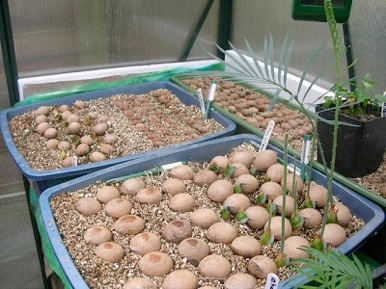HOMEPAGE | ATLAS & PHOTOGALLERY | EUROPEAN COLLECTIONS | HORTICULTURE | PROTECTION (cz) | CONTACTS | CZECH

HOMEPAGE | ATLAS & PHOTOGALLERY | EUROPEAN COLLECTIONS | HORTICULTURE | PROTECTION (cz) | CONTACTS | CZECH

Czech Cycads

Growing Cycads from Seed
Make sure you buy your seeds from a reputable seed-dealer and even better; from a cycad -seed farmer. There are many people offering seeds on various web- and auction-sites and many of them are only interested in shifting their goods, often at extreme prices.
Jan Methorst, United Kingdom
Find more text on cycads growing on our Czech language version
Check seeds for rattling and floating in water (although some species are designed to float like Cycas thouarsii). Cycad seeds when released by the plant, have immature embryo’s, which need (depending on genus) a further time to develop into maturity before being able to germinate.
If the seeds are not ready yet, I store them in nets at approx 15C and soak them for a couple of hours once a month. If these conditions are not met, the seeds will loose there viability, dry out and will never germinate. If the drying out is in an early phase, the seeds can be hydrated by soaking for an extended period of time.
If a ‘maturity time’ cannot be given by a seed-seller, ask for some extra seeds, so you can check the development of the embryo. Open the seed carefully and you will find a small canal from the middle of the seed from where the embryo grows towards the point where the radicle will emerge from the seed.(micropylar)
If the embryo is reaching the exit point of the seed, it is ready to plant.
Seed treatment before planting
Before you plant the seeds, make sure they are absolutely clean, because any bit of skin or fruit left on the seeds can cause a fungus outbreak, which will attack the emerging radicle and may cause your expensive seed to fail.
I clean the seeds extensively, soak them in industrial alcohol (80%) for 10 minutes, then remove any remnants with a toothbrush and leave the seeds in a mild fungicide for 1 hour, before planting .
If some seeds show fungus-growth even after several cleanings, the fungi usually comes from inside the seed, so remove it.
Germinating the seeds
There are many ways of germinating the seeds.
I plant all seeds of the genus Cycas, Encephalartos, Zamia, Bowenia, Macrozamia, Stangeria, half buried in vermiculite, with the temperature set at 28C. Always use fresh vermiculite. I water the seeds when they are dry, as long as there is a dark patch on the seed,there is enough dampness for germination.
Dioon and Ceratozamia, I pack tightly in damp peat in a plastic bag, which goes in a propagator at the same 28C.
If you have planted the seeds at or around the time of maturity, they can germinate within 2 to 6 weeks of planting time.
Some seeds take up to 5 years, but these are exeptions, still there is much truth in the saying ‘never throw away a cycad seed’
Some seeds although fully mature,don’t seem to want to germinate until you remove the thin cover where the radicle should appear (micropylar)
Replanting the seeds
When the first leaf emerges, depending on the need for space, I plant the seeds in deep pots and when hardened off,move the plants to the cool greenhouse.
I do not claim the above methodes are superior, but they work for me. Jan Methorst
Text and photos kindly provided to www.cykasy.cz by Jan Methorst

Photo: Encephalartos seeds in vermiculite in propagators
Holding periods
The time for each genus is approx as follows:
•Bowenia 1 to 3 months
•Ceratozamia 3 to 6 months
•Cycas 4 to 12 months
•Dioon 0 to 2 months
•Encephalartos - usually 6 months
•Lepidozamia 3 months
•Macrozamia 3 months
•Microcycas - very soon, usually 1 to 2 months
•Stangeria 1 to 3 months
•Zamia 0 to 2 months (with the exception of several rare species)

